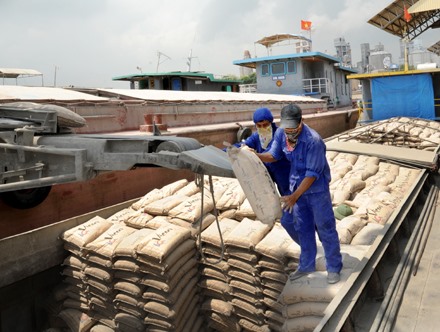The cement production industry may face increasing pressure from an anticipated excess of supply over demand, although the industry posted good sale results this year.

The cement production industry may face increasing pressure from an anticipated excess of supply over demand, although the industry posted good sale results this year.
The Ministry of Construction estimated cement and clinker sales at 95-96 million tonnes for the full year of 2018, up by 12 per cent over the previous year.
For 2019, sales of cement and clinker are expected to post a year-on-year increase of 6-8 per cent to reach 98-99 million tonnes.
According to the ministry, the total production capacity of the cement industry would reach 101.74 million tonnes in 2019, after two production lines are put into operation, bringing the total number of lines to 84 throughout the country.
The Viet Nam Cement Association previously estimated that upgrades and new investments would increase the production capacity of the industry to 120-130 million tonnes by 2020, while demand, including both domestic sales and exports, would be around 30 tonnes lower.
Recently, Prime Minister Nguyen Xuan Phuc asked the Ministry of Construction and the Viet Nam Cement Industry Corporation to review and report on the production capacity of the industry, new investments and market demand.
Exports
Sales of cement and clinker in January – November far exceeded the target for the full year.
According to the ministry’s Department of Building Materials, sales in the 11-month period reached 94.97 million tonnes, up by 44 per cent over the same period last year and 12 per cent higher than the annual target.
Domestic sales reached 66 million tones, equivalent to the plan for the full year. However, exports reached 28.97 million tonnes, 65 per cent higher than the target.
According to the ministry, cement and clinker exports would total 29-30 million tonnes this year, up by 50 per cent over last year, with revenue hitting the US$1 billion threshold, at $1.17 billion.
Nguyen Quang Cung, the cement association’s president, said that cement exports had increased after China shut down polluting cement plants and forced some to cut production.
Exporting excess cement was a solution when production is much higher than domestic demand.
However, a significant increase in the export of cement faced problems when the Government asked for a limit on the export of natural resources.
Another problem was that Viet Nam’s cement export price was low, at around $48-50 per tonne, compared to other countries such as Thailand ($65), Indonesia ($102) and the Philippines ($100).
An expert said that exporting large volumes at low prices was a waste of natural resources.
In May, the Government issued Document No 4721/VPCP-CN asking the ministries of construction and finance to come up with solutions to improve the efficiency of natural resources, energy and labour productivity in the cement industry as well as limiting exports.
This aims to make the cement industry focus more on the domestic market for sustainable development.
Also in May, the Government asked the construction ministry to design a development strategy for the cement industry to 2030, to ensure balanced supply and demand.
The construction ministry said the top priority would be given to completing the compilation of the strategy for approval.
In addition, the ministry would enhance the application of science and technology to reduce production costs, promote energy and resources savings, and reduce the environmental impact of cement production. — VNS





